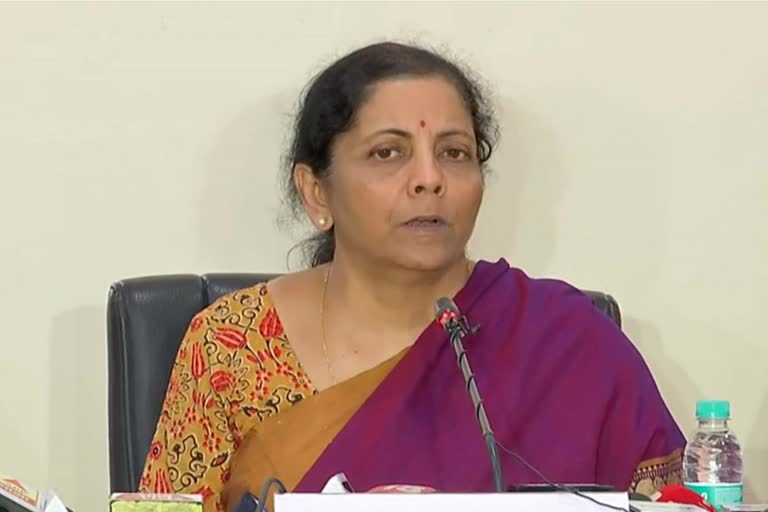New Delhi: Finance Minister Nirmala Sitharaman said on Saturday that several significant steps in structural reforms have been taken in the past few months and responses/interventions addressing the needs of the economy will continue, indicating more relief measures could be on the anvil if so needed.
The FM's statement came a day after it was announced that the GDP growth rate of the country went down to 4.5 per cent, slowest in over six years.
"Today, we mark the completion of six months of the second term of @PMOIndia @narendramodi. Several significant steps in structural reforms have been taken in these months. Responses/interventions addressing the needs of the economy will continue", the FM tweeted in response to a tweet by Prime Minister Narendra Modi.
-
Today, we mark the completion of six months of the second term of @PMOIndia @narendramodi. Several significant steps in structural reforms have been taken in these months.
— Nirmala Sitharaman (@nsitharaman) November 30, 2019 " class="align-text-top noRightClick twitterSection" data="
Responses/interventions addressing the needs of the economy will continue. #6MonthsOfIndiaFirst
">Today, we mark the completion of six months of the second term of @PMOIndia @narendramodi. Several significant steps in structural reforms have been taken in these months.
— Nirmala Sitharaman (@nsitharaman) November 30, 2019
Responses/interventions addressing the needs of the economy will continue. #6MonthsOfIndiaFirstToday, we mark the completion of six months of the second term of @PMOIndia @narendramodi. Several significant steps in structural reforms have been taken in these months.
— Nirmala Sitharaman (@nsitharaman) November 30, 2019
Responses/interventions addressing the needs of the economy will continue. #6MonthsOfIndiaFirst
Interestingly, the PM has also listed most economic steps of the government saying India is on track of becoming a 5 trillion dollar economy by 2014.
The target of 5 trillion dollars has come under heavy scrutiny after the dismal growth in the last two quarter marking the six months of the current government though part of the April-June quarter fell into the last government duration which was also the NDA government.
Former RBI Governor and noted economist C Rangarajan has said the 5-trillion dollar target simply out of question by 2025 at the current growth rate.
While the first-quarter growth slipped to a six-year low of 5 per cent, the second quarter growth has now further slipped to 4.5 per cent now. Even RBI has lowered its growth full-year forecast in two months to 6.1 per cent in its October policy review.
As on steps, Sitharaman slashed the corporate tax rate to 22 per cent from 30 per cent for existing companies, and to 15 per cent from 25 per cent for new manufacturing companies. Including a surcharge and cess, the effective tax rate for existing companies would now come down to 25.17 per cent from 35 per cent which involved an outgo of Rs 1.45 lakh crore. Companies can opt for higher tax rates or new ones.
The government also brought changes in IBC where now NBFCs With Rs 500 Crore Assets Can Go For Insolvency Resolution bringing the finance companies under the ambit of insolvency. Its already notified and DHFL is already in NCLT. This came against the backdrop of the ongoing liquidity crisis in the NBFCs that has also sparked concerns about the overall stability of the financial sector.
Read more:Experts on GDP numbers: 'Worst is not past us'
Under the NBFC liquidity injection response of the government, there have been steps. Public sector banks have been sanctioned to purchase Rs 21,580 crores of pooled assets as on October 16. Moreover, the National Housing Bank has also extended Rs 30,000 cr worth of credit lines to NBFCs.
Housing sector received maximum attention like NBFCs during these six months. The Centre had announced a Rs 25,000 crore stimulus package for the ailing real estate sector earlier this month.
Sitharaman had announced that the government plans to give impetus to the housing market to revive over 1,600 stalled housing projects covering 4.58 lakh units and now this window will be operational in two months, DEA secretary Atanu Chakraborty has said.
The decision will also generate considerable employment, revive demand of cement, iron and steel industries and relieve stress in other major sectors of the economy, according to the government.
On the mega-merger of 10 PSU banks which was also a marquee announcement in these six months, the mergers have been moving on with various approvals to start new structures as on April 1, 2020.
The PSU Banks have also been capitalised with Rs 55,250 crore bonds. However, Credit growth to the industry decelerated marginally to 3.4 per cent in October 2019, from 3.7 per cent in October 2018, according to the Reserve Bank of India's (RBI's) sectoral deployment of credit data.
The government has also gone some steps towards meeting the huge disinvestment target where it took decisions on privatising BPCL, Concor and SCI along with the decision to pare stakes below 51 per cent without losing PSU characteristics. Advisors have been appointed for BPCL and on Air India privatisation, roadshows have been held.
The success of both these divestment exercises are crucial to the meeting of target and also providing revenues to the government which is likely to face a shortfall on account of tax revenues.
The CGA data showed that the government's revenue receipts during the April-October period of 2019-20 rose to 46.2 per cent of the Budget Estimate as compared to 45.7 per cent in the corresponding period last year.



